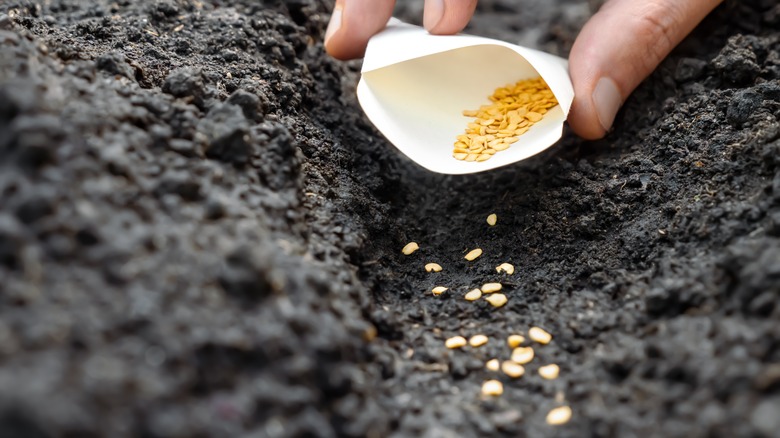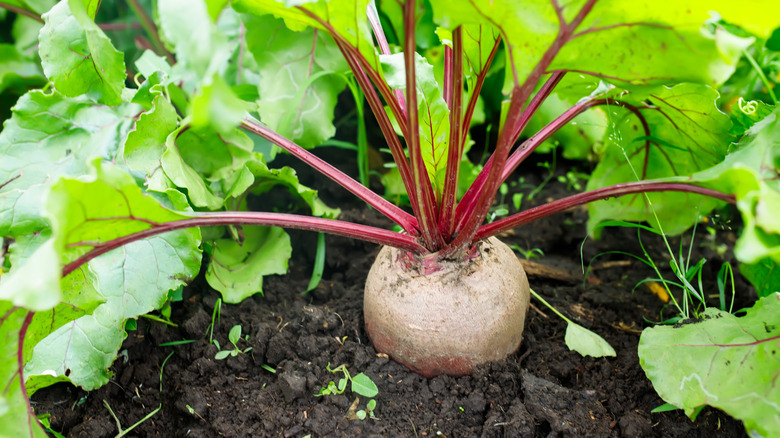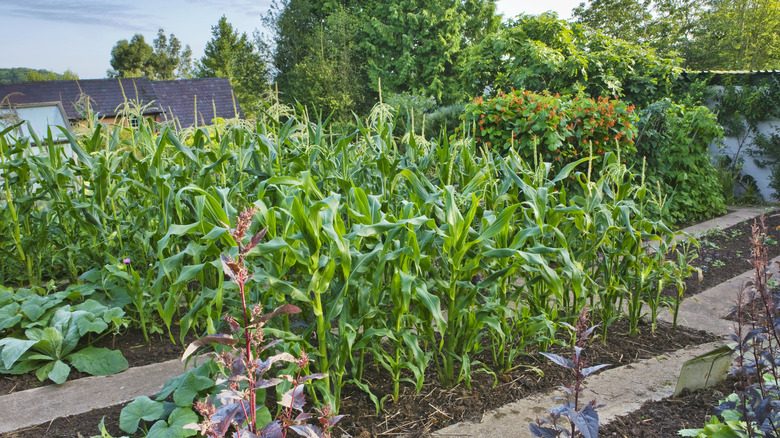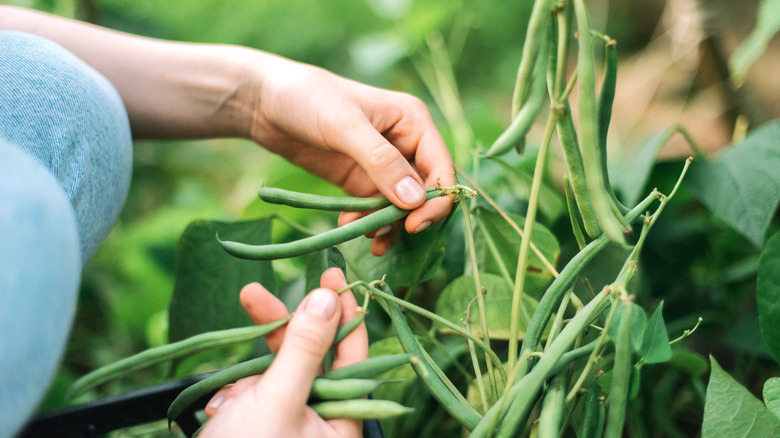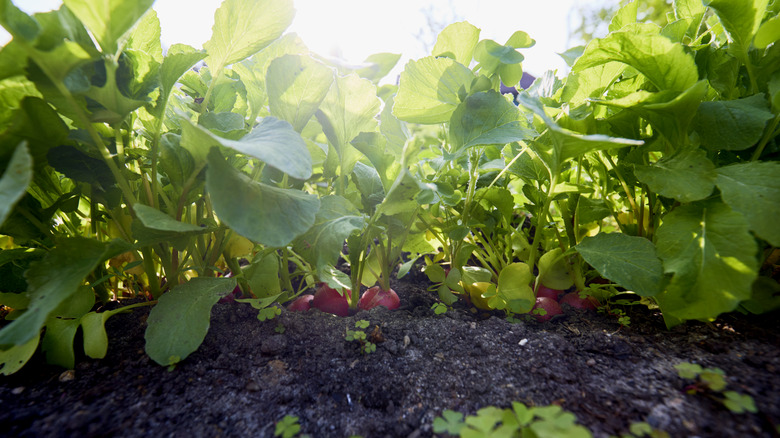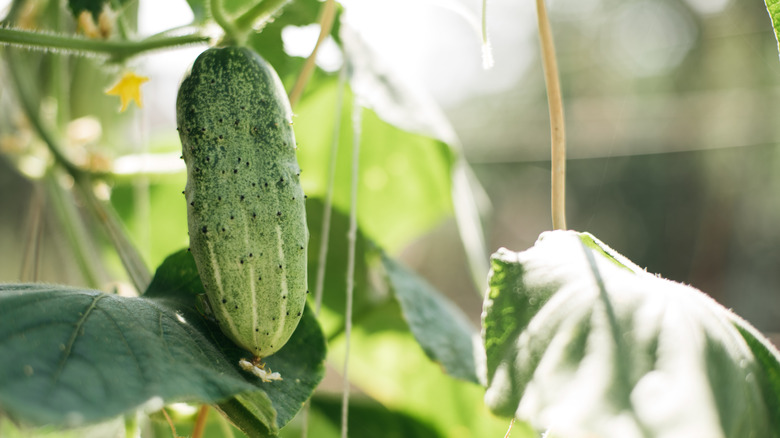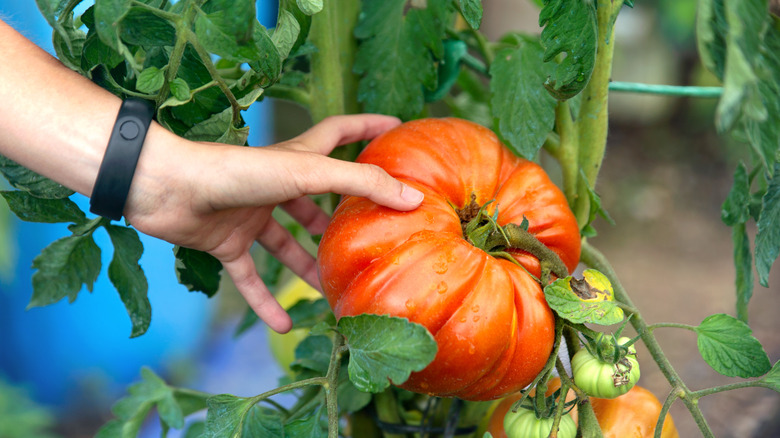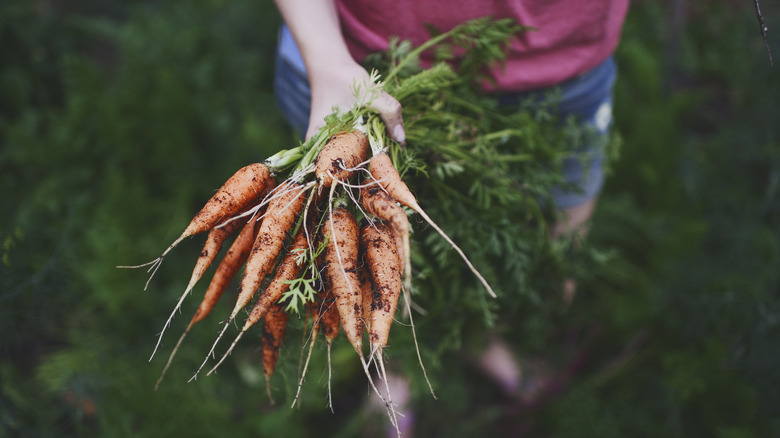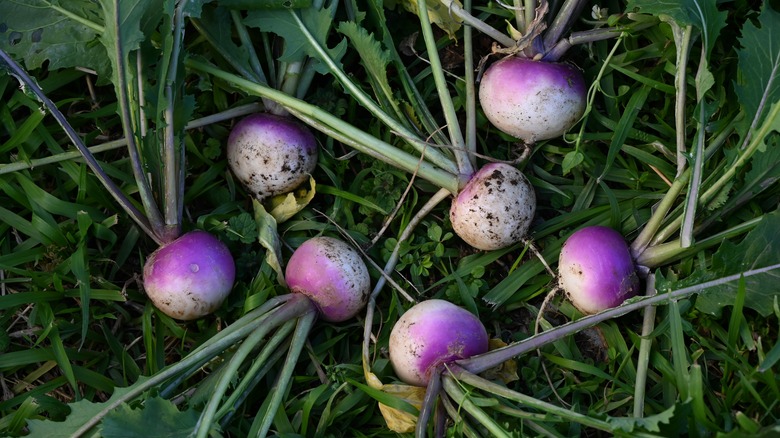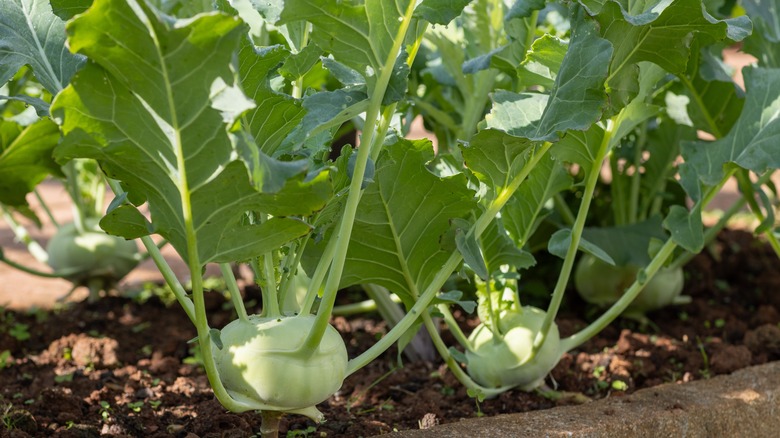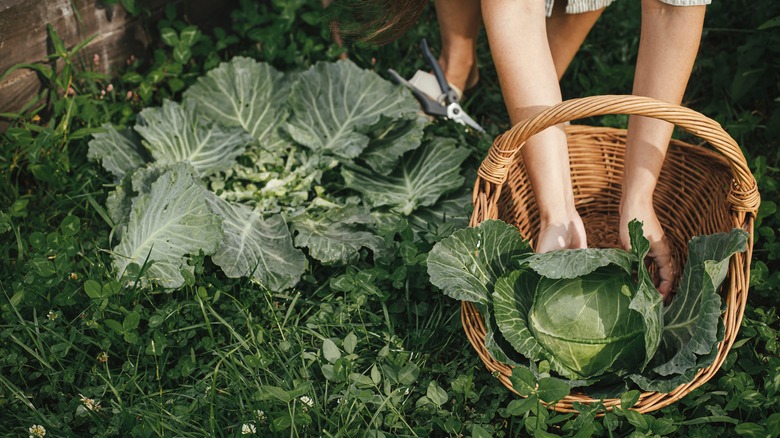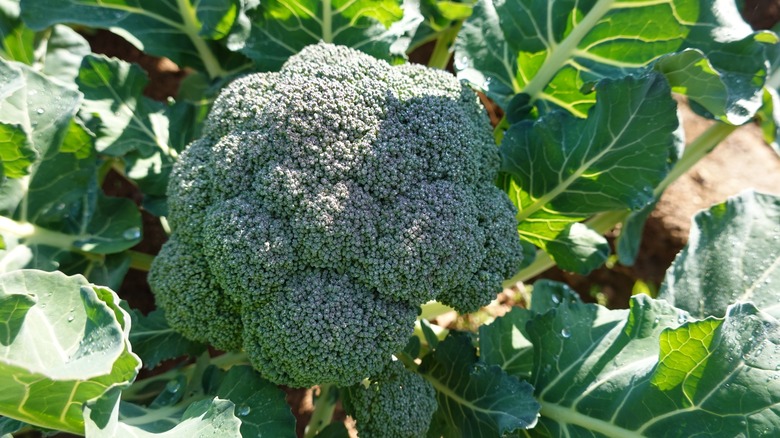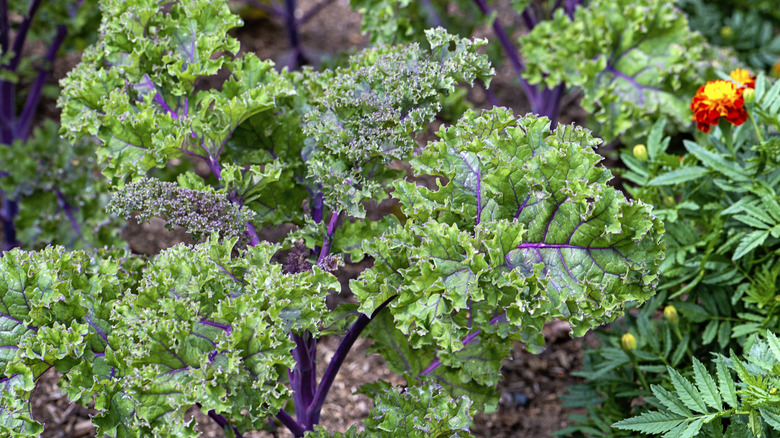12 Easy Vegetable Seeds To Grow To Add Flavor To Your Garden
Edible gardens are extremely convenient and fun to grow, not to mention that there's a very special joy associated with harvesting and cooking the fruits of your labor. But as a home gardener, you may feel that starting a vegetable garden from seeds is a bit of a gamble. The seeds may not germinate at all, the seedlings may wither before maturing, and even established plants may fail to deliver crops. Some vegetables are indeed difficult to grow in a garden, so these fears may be well-warranted.
But fortunately, there are plenty of veggies you can easily start from seeds and grow with minimal preparation and maintenance. Most root vegetables, like beets, brassicas, and even culinary staples like cucumbers are excellent options to start from seed if you're a beginner. Below, we've lined up 12 vegetables that happily grow from seeds with little exertion on your part. Each of our picks contributes unique flavor, beneficial nutrients, and versatility to the dinner table, too. You'll learn the optimal conditions for planting these vegetable seeds in the garden and basic care instructions for the seedlings.
1. Beets
Beets' (Beta vulgaris) sweet and earthy flavor makes them a delicious addition to salads and soups, and these vegetables require precious little effort to grow from seed. In fact, you don't even need to plant them in indoor containers first — you can plant the seeds directly into the ground, at a depth of ½ inches. If you're planting in spring, the best time to sow the seeds is after the soil temperature stays above 45 degrees Fahrenheit. For a fall harvest, plant in August instead. Planting in batches ensures that you have a consistent supply of beats all season long.
2. Sweet corn
Do you enjoy corn in puddings, salads, as popcorn, or simply on the cob? If you do, there's no need to splurge on it at the grocery store. Sweet corn (Zea mays l.) is an excellent beginner crop that grows from seed without issues as long as you meet a few simple demands. These include fertile soil with a pH level of 6.0 to 6.8, soil temperatures that are sufficiently warm for germination (at least 60 degrees Fahrenheit) and lots of sun. Once its hardy seedlings germinate, they can even withstand light frost thanks to the protective nature of its leaves.
3. Green beans
There is an immense variety of edible beans, all of which make a unique, tasty, and healthy contribution to the dinner table, including green beans (Leguminosae). They are easy to grow from seeds, and are a suitable option for gardens with limited space, since many varieties grow on poles. Start your bean patch once soil temperature no longer falls below 48 degrees Fahrenheit, otherwise the seeds may rot. Plant the seeds about 1 inch deep and space them at 2 inches. If you're growing a pole bean variety, the pole or trellis should be in place before you plant the seeds.
4. Radishes
If you're looking to give your meals a healthy, spicy boost with an easy-to-grow vegetable, look no further than the humble radish (Raphanus sativus). To grow successfully from seeds, they have but one ask — that you don't plant them too late in the season, and that you don't cram the seeds too close together. The ideal planting time is after the soil temperature gets to 65 degrees Fahrenheit. Plant by inserting the seeds just a ¼ inch into the soil, spreading about 25 seeds for every 12 inches. Then, thin the seedlings to less than 12 plants per half a foot.
5. Cucumbers
Whether you're a salad connoisseur or a dedicated pickler, nothing beats having a supply of homegrown cucumbers (Cucumis sativus) — especially because they're low maintenance and easily grow from seed. Plant the seeds directly in the garden in late spring or early summer, once the soil temperature surpasses 70 degrees Fahrenheit. Alternatively, start the seeds in containers indoors, about a month-and-a-half before the last frost date. The planting medium should comprise a mix of soil and compost. Then, harden the seedlings by leaving the pots out on warm days before transplanting.
6. Tomatoes
Like cucumbers, tomatoes (Solanum lycopersicum) are a salad and pickling staple. They're also a beginner-friendly vegetable that anyone can grow in warm, sunny, conditions. You should start these seeds indoors in mid-spring. To germinate successfully, you'll need to keep the planting medium at temperatures that stay above 64 degrees Fahrenheit. A heat mat and plastic cover should help you maintain sufficient warmth. Then, the seedlings should finally emerge in about a few weeks. Once the young plants have an established root system and the outdoor temperatures doesn't dip below 60 degrees, transplant them to a sunny location in the yard.
7. Carrots
Sow carrot seeds (Daucus carota) in your yard, and you'll have a months-long supply of the juicy vegetable in the kitchen. You can sow carrot seeds as early as right after the last frost, and continue sowing until the end of summer — this way you'll get harvests from late spring to early winter. The ideal soil temperature for carrot seeds is above 45 degrees Fahrenheit. However, it's important to water the soil thoroughly before planting, then sow the seeds at a shallow depth of ¼ an inch. To prevent evaporation, shield the soil with a row cover until seedlings emerge.
8. Turnips
You can eat turnips (Brassica rapa) in a variety of ways, including baked, roasted, mashed, or even raw in a salad. Luckily, this versatile and healthy vegetable makes for an easy start from seeds. You can grow turnips for spring or fall harvests (or both) with mid-spring and early August planting dates. Sow the seeds in fertile, slightly acidic soil, roughly 2 inches apart. The germination takes less than two weeks, and normally, you'll see the seedlings sprout in 10 days. You'll need to thin the seedlings to achieve a spacing of 4 to 5 inches between the plants.
9. Kohlrabi
Kohlrabi (Brassica oleracea var. gongylodes) is a juicy vegetable whose large, slightly sweet bulbous stem works well in salads, stews, and stir-fries. You can grow kohlrabi from seed directly into the garden either in mid-April for a summer harvest. Note that if your region is used to getting late frosts, these could cause the seedlings to bolt, meaning the plants start to flower instead of growing the crop. For fall crops, plant kohlrabi seeds in mid-July instead. If you plant in the summer, shield the seedlings from insects and high temperatures. Protecting the seedlings with a row cover should help.
10. Cabbage
Cabbage (Brassica oleracea) is a great vegetable to have around just because you can use it in a vast assortment of culinary concoctions. Growing it from seeds is easy. One key condition for a successful harvest is planting the seeds in a spot where you haven't grown other cruciferous vegetables in the last four years. For a summer harvest, start the seeds indoors in early April, then condition the seedlings and transplant them into the garden once the air temperatures stay above 40 degrees. Otherwise, plant the seeds outdoors in July and the crops will be ready three months later.
11. Broccoli
Broccoli (Brassica oleracea) is well-known as a nutrition powerhouse, and is as versatile in different yummy recipes as its cabbage cousin. You should plant these cold-hardy vegetables in the garden in a sunny spot and a rich growing medium with a pH of 6.0 to 6.5 in the spring. Alternatively, you can plant them indoors in late winter and transplant the seedlings to the garden in May. Broccoli plants should have around 2 feet of space between them, as they can grow quite large. These plants require sufficient watering before and after they reach maturity.
12. Kale
Kale (Brassica oleracea var. acephala) is a salad and stir fry superfood that's packed with beneficial nutrients like fiber and folates. Like its broccoli and cabbage relatives, kale is easy to grow from seeds as long as you plant it at the right time and the soil is fertile and well-draining. For a harvest that lasts from summer to winter, plant kale directly in the ground, staggering the dates from mid-spring to mid-summer. Sow about four or five seeds in each shallow, ¼-inch hole, then thin the seedlings until you reach a spacing of roughly 2 feet between the plants.
